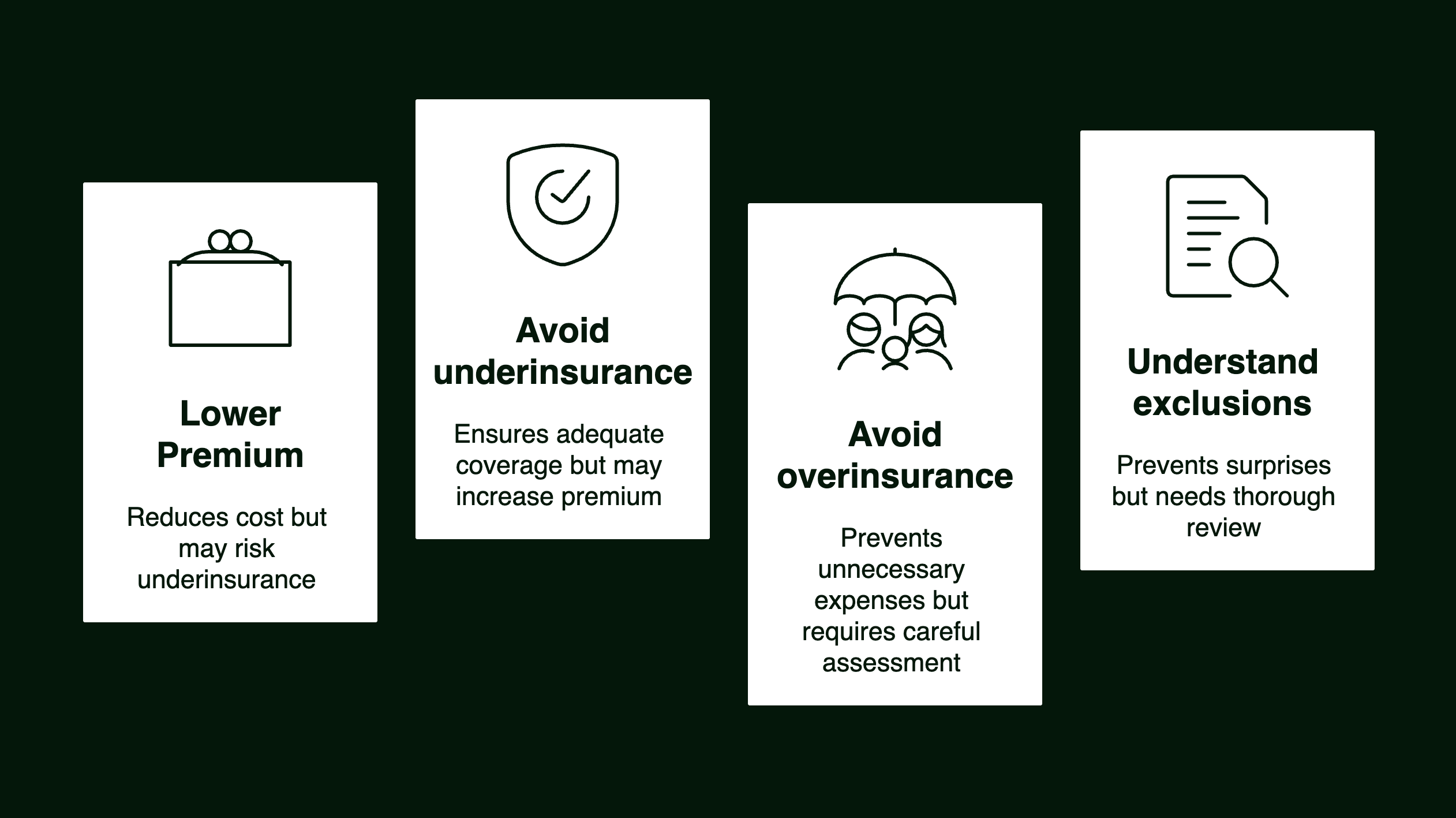.jpg)
Is Building Insurance the Same as Home Insurance? Key Differences Explained
Is building insurance the same as home insurance? Not quite. Many people assume building insurance and home insurance are interchangeable, but they provide different types of protection. This guide breaks down what each one covers, who needs which type, and how to choose the right policy for your home.
Whether you’re insuring a flat or a high-value property, getting the right cover matters. rivr offers buildings insurance designed for modern homeowners, with up to £3 million in rebuild cover, digital-first servicing, and clear, flexible terms.
We’ll also look at common exclusions, rebuild cost tips, and how contents insurance fits into your overall protection.
What is building insurance?
Building insurance protects you from unforeseen circumstances that could damage your home or possessions. There are several types of home insurance available, including buildings, contents, and combined policies.
Buildings cover protects the structure of your home from a range of risks. It covers the cost of repairs for structural damage caused by events like fire or storm.
What is and isn't covered in building insurance?
Do you need buildings, contents, or both?
Buildings insurance protects your home’s structure and permanent fixtures. This includes the roof, walls, floors, fitted kitchen and bathroom, and outbuildings.
Contents insurance covers your belongings: furniture, electronics, appliances, clothing, and more. This includes both personal belongings and high-value items that are part of your everyday life. Protecting your own possessions is just as important as insuring the structure itself.
Note: Some providers also offer student contents insurance, which is tailored to students living in shared or university accommodation.
Most homeowners need both. If you have a mortgage, buildings cover is usually required. Tenants only need contents insurance. Landlords must insure the building, but contents insurance is only necessary if the property is furnished.
Combined vs separate home insurance policies

Home insurance usually refers to a combined policy that includes both buildings and contents cover. This type of policy protects your property's structure and your personal belongings, such as furniture, electronics, and kitchen appliances. Contents insurance policies vary, so always check the limits and exclusions to ensure adequate cover.
For some homeowners (particularly those with listed buildings or high-value contents) separate policies may offer more flexibility. rivr also offers standalone contents insurance tailored to homes with valuable possessions.
What does buildings insurance protect against?
Standard buildings insurance covers damage from:
- Fire
- Flood
- Storms
- Vandalism
- Subsidence
- Burst pipes
Optional extras can include:
- Accidental damage
- Legal expenses
- Home emergency cover
- Personal possessions outside the home
Specialist policies like holiday home insurance may be required if your property is often unoccupied.
What is the rebuild cost?
.jpg)
Buildings cover is based on the cost of rebuilding the structure of your home; not the market price. The rebuild cost reflects the full cost of reconstructing your property from scratch, including materials and labour. It’s vital that your policy reflects your current rebuild value to avoid being underinsured
Who’s responsible for arranging cover?
- Homeowners: Usually responsible for both buildings and contents insurance
- Landlords: Must have landlord building insurance to protect the property’s structure. Contents insurance only if the property is furnished
- Tenants: Only need contents insurance for their own belongings
Case study: Simon’s unoccupied property and buildings insurance claim
Understanding the difference between buildings insurance and home insurance is crucial, especially when it comes to policy exclusions and claims.
The following real-life case highlights how these distinctions can affect what is and isn’t covered when unexpected damage occurs.
A fire damaged Simon’s property during renovation, but his buildings insurance provider initially refused the claim, citing an unoccupied property exclusion. The case shows how relying solely on buildings insurance arranged through a mortgage may not provide full protection, especially if the property isn’t being used as a home.
What this case highlights:
- Buildings insurance may not cover damage caused if a property is left unoccupied beyond the policy limit (often 30 days).
- The definition of "unoccupied" varies by insurer and may depend on maintenance and visitation frequency.
- Contents insurance is needed to protect possessions, but Simon’s claim involved the building structure only.
How to calculate your home’s rebuild cost
Calculating your rebuild cost is essential for getting the right level of cover. Here’s how to do it:
- Check your property’s details: Look at your deeds or mortgage documents for information about your home’s size and construction.
- Use a rebuild cost calculator: Many insurers and industry bodies offer free online calculators.
- Consider professional advice: For unusual or listed properties, a surveyor can provide an accurate estimate.
- To get an accurate figure:
- Use a rebuild cost calculator (e.g. BCIS)
- Or ask a chartered surveyor, especially if your property is non-standard
Remember, buildings insurance is based on rebuild cost, which is usually lower than your home's market value. This distinction is crucial when calculating cover.
Expert tips, exclusions, and choosing the right policy

Choose the right level of cover
Choosing the right insurance means balancing cost with the level of protection your property needs. Rather than choosing the cheapest option, make sure it suits your property type, risk profile and rebuild cost.
Lower your premium without cutting corners
Start by reviewing your policy each year to ensure it still reflects your current circumstances, especially after home improvements or large purchases. Installing approved security features like smart alarms, CCTV or reinforced locks can help lower your premium.
If you're looking to save, consider increasing your voluntary excess. This may reduce your monthly premium, but only if you can comfortably afford the excess in the event of a claim.
Bundling policies such as home and car insurance can also lead to discounts. Maintaining a no-claims bonus and joining a Neighbourhood Watch scheme may further reduce your premium.
Avoid underinsurance and overinsurance
Accurate valuations are essential. Not getting adequate cover can leave you financially exposed, while overinsuring may result in paying more than necessary. Use online rebuild calculators and take inventory of your contents.
Understand what is excluded
Standard home insurance often does not cover:
- Wear and tear or gradual deterioration
- Neglect or poor maintenance
- Damage from pests or infestations
- Pre-existing damage
- Homes left unoccupied for more than 30 days, unless specified in the policy
If anything in your policy is unclear, contact your insurer for clarification. Homes with unusual features or increased risks, such as listed properties or those in flood zones, may require specialist cover.
Checklist: choosing the right home insurance
Ask yourself:
- Do you own or rent your home?
- Do you need buildings, contents, or both types of cover?
- Have you calculated your rebuild cost accurately?
- Have you checked for exclusions or policy limits?
- Have you compared quotes from multiple providers?
- Do you need any optional extras, like legal cover or emergency assistance?
- Are you reviewing your policy annually to stay protected?
rivr: tailored policies for high value buildings

We design flexible buildings and home insurance for high-value properties. Our clear terms, digital-first service, and expert support make it easy to get cover built around your needs.
Contact are team today to see how we can help.
Read more
Frequently asked questions
It depends on the repair cost and your excess. Minor cosmetic issues may not justify a claim, but significant structural damage usually will. Always check your policy and think about long-term costs before deciding.
No. Buildings insurance covers only the physical structure of a property, including walls, roof, and permanent fixtures. Property owners insurance includes buildings cover but also protects landlords against risks like loss of rent, legal liability, and damage to landlord-owned contents. It is designed for those renting out property, not just owning it.
Buildings insurance covers damage to the structure of a property, including risks such as fire, flood, or subsidence. Whereas indemnity insurance protects against legal or documentation issues, such as missing planning permission or access rights. It is typically arranged during property transactions to cover historic risks identified during conveyancing.





